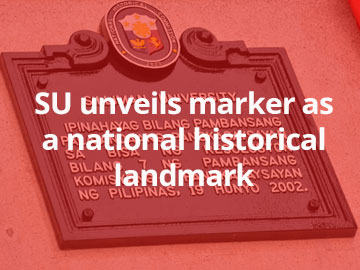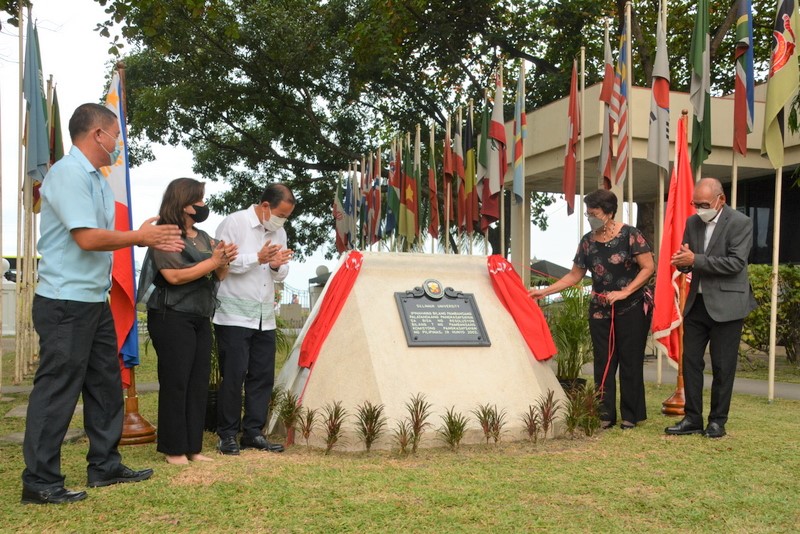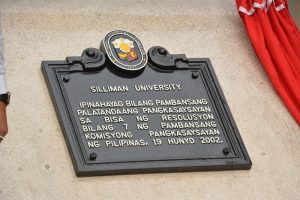
SU unveils marker as a national historical landmark

(L-R) Dr. Earl Jude Paul L. Cleope, SU vice president for academic affairs and NHCP commissioner; Carminda R. Arevalo, NHCP Office of the Executive Director OIC; Dr. Rene R. Escalante, NHCP chairman; Dr. Betty Cernol McCann, SU president; and Ricardo A. Balbido, Jr., SU Board of Trustees chair unveil the marker from the NHCP declaring SU as a national historical landmark, September 23, 2022 at the Leopoldo T. Ruiz Administration Hall grounds.
Silliman University (SU) unveiled a marker signifying its status as a national historical landmark, September 23, 2022 at the Leopoldo T. Ruiz Administration Hall grounds.
SU has been a national historical landmark since June 19, 2002 when the National Historical Commission of the Philippines (NHCP) recognized SU’s historical significance through Resolution No. 7, S. 2002.

Dr. Rene R. Escalante, NHCP chairman
Dr. Rene R. Escalante, NHCP chairman, attended and gave a message during the inauguration ceremony of the new marker in front of the members of the SU Board of Trustees, administration officials, deans, and office heads who also attended the ceremony.
Escalante said SU as a national historical landmark is classified under Level I, the highest recognition level from the NHCP, having both an official declaration and marker from the NHCP.
Dr. Betty Cernol McCann, SU president, expressed gratitude for the NHCP recognition and for Escalante’s presence during the ceremony.

(L-R) Dr. Earl Jude Paul L. Cleope, SU vice president for academic affairs and NHCP commissioner; Dr. Rene R. Escalante, NHCP chairman; Dr. Betty Cernol McCann, SU president; and Carminda R. Arevalo, NHCP Office of the Executive Director OIC sign the document signifying SU as a recipient of the historical marker from NHCP.
Dr. Earl Jude Paul L. Cleope, the SU vice president for academic affairs and a commissioner of the NHCP, said Escalante initiated the installation of a historical marker when the NHCP chairman visited the SU campus before the pandemic and saw that the marker installed at the Administration Hall grounds needed to be replaced.
The previous marker, which Cleope called an “institutional marker,” described a short history of SU but did not mention SU’s status. The previous marker is now at Silliman Hall, on a wall between the entrance to the main function hall of the first floor and the stairs going to the second floor.
Meanwhile, the new marker acknowledges SU’s status as a national historical landmark.
According to NHCP’s guidelines, a national historical landmark is a “site or structure closely associated with a significant historical event, achievement, characteristic, turning point, or stage in Philippine history, or a structure made or created by a national hero.”
National Historical Landmark since 2002

The new historical marker at the Leopoldo T. Ruiz Administration Hall grounds.
Part of NHCP’s mandate is to protect recognized historic sites and structures. The declaration made by NHCP recognizing SU in 2002, said Cleope, was instrumental in protecting the campus from the threat of a reclamation project proposed by the Philippine Ports Authority during that time.
The 2002 declaration recognizes SU as the “first American private school” in the Philippines and a “witness and participant to the unfolding Philippine history since the advent of American occupation to the present day,” that has contributed to the “educational, religious and social development of Negros Oriental and the Philippines.”
The declaration also recognizes buildings in SU that “exemplify Philippine architecture in its various development stages during the American colonial period,” and “stand out today as notable representatives of vintage American period or pre-war architecture,” namely: Silliman Hall (built 1903), Katipunan Hall (1915), Science Building (1917), Guy Hall (1918), Oriental Hall (1921), the Amphitheater (1921), Channon Hall (1923), the old Library (1927), Hibbard Hall (1932), Scheide Chapel (1937), and the Davao Cottage.


